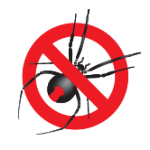
PEST CONTROL FOR GOVERNMENT FACILITIES
Maintaining a clean and healthy environment in government facilities such as public housing, schools, hospitals, and community centres is crucial for the well-being of the occupants, employees, and visitors. On the Northside of Brisbane, pest control measures are particularly important as the region is prone to various pest infestations, posing health risks and causing damage to property. Proper pest management and control are essential to prevent the spread of diseases and to maintain a clean, safe, and comfortable environment for everyone.
The Public Health Act 2005 and the Public Health Regulation 2018 implement pest control requirements for certain public facilities, including government-operated properties. These provisions ensure that pest infestations are dealt with promptly by relevant authorities or approved pest management companies.
The significance of pest control for government buildings and facilities
Pest control is a vital aspect of maintaining a clean, functional, and comfortable environment in all buildings, including government facilities.
Health Hazard Prevention
Pest infestations in government facilities can considerably contribute to the spread of various illnesses and diseases. Pests, such as rodents, insects, and birds, are notorious carriers of germs that can cause severe health complications for humans. For example, cockroaches can spread bacteria like Salmonella and E. Coli, while rodents are known carriers of the Hantavirus.
By implementing regular pest control measures in government facilities in Brisbane’s Northside, it’s possible to limit the population of these disease-carrying pests and effectively reduce the risks associated with their presence.
Property Damage Prevention
Pests such as termites and rodents can cause significant property damage if left unchecked. Termites consume wood, causing structural damage to buildings, while rodents chew through electrical wiring and insulation materials. This not only leads to costly repairs but can potentially put lives at risk through fires or structural collapses.
Regular pest control measures help identify signs of infestation early on, allowing for rapid intervention before significant damage is done. This is essential in keeping the buildings safe and functional, while also sparing taxpayers the high costs of repairs.
Improved Quality of Life
A pest-free environment can drastically improve the quality of life for occupants and employees within government facilities. The presence of pests can negatively impact people’s mental and physical well-being, leading to anxiety, discomfort, and a general feeling of disgust.
By maintaining a clean and pest-free environment, occupants and employees of government facilities can feel at ease and improve their overall happiness and productivity.
Positive Reputation for Government Facilities
Government facilities are meant to be safe, hygienic, and well-maintained spaces for public use. Proper sanitation and hygiene practices, including pest control measures, are crucial in maintaining a positive reputation for these facilities.
A clean and pest-free environment demonstrates the government’s commitment to the health and safety of the people who use these spaces. Implementing proactive pest control measures is a great way to show that the government takes the well-being of its citizens and employees seriously.
Pest control process for government facilities
The pest control process for government facilities typically involves the following steps:

1. Inspection & identification
A thorough inspection of the premises is conducted to determine the type and extent of the infestation.

2. Customised treatment
A tailored pest control plan is designed to address the specific needs and requirements of the facility.

3. Pest control implementation
The chosen treatment is applied by skilled and experienced technicians using appropriate equipment and eco-friendly solutions.

4. Monitoring & follow-up
Monitoring & follow-up: regular follow-ups and monitoring are conducted to ensure the effectiveness of the treatment and prevent recurrence.
Getting on top of pest management in government facilities
Just like any other establishments, government facilities are not spared from the invasion of diverse pests that can create a range of problems, including health risks and structural damages. Maintaining a pest-free environment is crucial for these places to help ensure a productive and healthy work setting – an aspect that is particularly vital among government offices that serve the public.
Here are the various pests that are frequently encountered in government facilities, and how they can be managed and controlled to prevent potential negative impacts.

Termites
Termites are notorious for their wood-eating habits, which can spell disaster for a heavily timber-structured facility. Timely intervention through regular inspections and professional pest control measures is crucial to prevent and minimise the extent and possibility of long-term structural damages.

Rats and Mice
Rodents such as rats and mice are particularly troublesome; they have the potential to carry diseases, gnaw through electrical wires, and cause structural damage. Implementing effective rodent control strategies like integrated pest management, trapping, and baiting systems is necessary to keep their population in check.

Cockroaches
These adaptable critters can thrive in various environments and can pose health hazards due to the pathogens they can carry. Cockroach management in government facilities should focus on practising good sanitation, proper food storage, as well as seeking professional help for a proper extermination plan.

Ants
While ants may not be as destructive as other pests, their colonies can grow to considerable numbers, leading to a full-scale infestation if not addressed promptly. Eliminating potential food sources, sealing entry points, maintaining foliage-free gutters and engaging the services of pest management professionals can aid in combating ant infestations.

Bed Bugs
Bed bugs can easily hitchhike their way into government facilities through staff and visitors. These pesky bugs may not transmit diseases, but they can cause discomfort and stress. Early detection, combined with regular cleaning and professional pest control services, can help prevent their proliferation.

Fleas and Ticks
Fleas and ticks can be introduced into a facility through animals or visitors. Addressing this issue requires a comprehensive approach that includes hiring extermination services to eliminate them from the premises using the correct procedures and treatment.

Spiders
Although the majority of spiders found in Australia are not harmful to humans, their presence in government facilities could create discomfort among employees and visitors. Integrated pest management strategies can help regulate the spider population within these workplaces.

Silverfish
Silverfish are known to feed on various materials, including paper and glue – substances often found in abundance within government facilities. Combatting these pests requires a well-rounded approach that includes maintaining a clean and dry environment, vacuuming regularly, and seeking professional help for effective silverfish management.
Cost of pest control for government facilities
The cost of pest control varies depending on the facility’s size and the extent of infestation. Little Critters Pest Control & Termite Management Specialists Brisbane offers competitive rates and customised solutions to accommodate the unique requirements of each government facility.
Why choose Little Critters Pest Control for your government facility
Government facilities, from office buildings to public amenities, can be at risk of pest infestations that not only pose health risks but also compromise structural integrity. When faced with this challenge, it is essential to choose a reliable and efficient pest control service to protect your facility and staff.
Little Critters Pest Control & Termite Management Specialists Brisbane is the ideal choice for pest control in government facilities, thanks to their expertise, professionalism, and commitment to customer satisfaction.
Effective and Eco-Friendly Pest Control Solutions
Little Critters Pest Control & Termite Management Specialists Brisbane understands the importance of adhering to strict environmental and safety regulations, ensuring the well-being of both employees and the public. They utilise eco-friendly pest control solutions that are highly effective in eliminating various pest species, all while being gentle on the environment and minimising potential hazards.
Highly Skilled and Experienced Technicians
When dealing with pests in government facilities, it is crucial to work with technicians who are fully equipped to handle such tasks with precision and professionalism. Little Critters Pest Control’s team of highly skilled and experienced technicians guarantees top-quality service with extensive knowledge on the latest pest control techniques and methods. Their expertise ensures a thorough and efficient job, safeguarding your facility from any future infestations.
Customised Pest Management Strategies for Various Facilities
Different government facilities have different pest control needs, due to variations in layout, location, and function. Little Critters Pest Control & Termite Management Specialists Brisbane recognises this and provides tailored pest management strategies to suit the unique requirements of each facility. By conducting a comprehensive site assessment, they customise a pest control plan that addresses existing issues and anticipates potential problems, providing you with the most effective solutions to protect your facility.
Competitive Pricing and Exceptional Customer Service
Maintaining a budget can be a major concern in government operations. Little Critters Pest Control understands this, and offers competitive pricing on their pest control services without sacrificing quality. Additionally, their exceptional customer service team works tirelessly to ensure a smooth and hassle-free experience for all clients. From initial consultation to delivering post-service support, their dedicated team is focused on ensuring complete customer satisfaction.
FAQ about pest control for government facilities
Why is pest control essential for government facilities?
Pest control is crucial for government facilities as it helps maintain a safe, clean, and healthy environment for employees and visitors. Pests such as rodents, insects, and termites can cause structural damage, spread diseases, and create an unsanitary environment, which can lead to health risks, reduced productivity, and negative public perception. Moreover, many government facilities house sensitive equipment and materials that can be damaged or contaminated by pests, leading to significant consequences and financial losses.
What kind of pest control measures should government facilities implement?
The specific pest control measures needed for government facilities vary depending on the type and size of the facility, as well as the pests present in the area. However, some common measures for an effective pest control program include:
– Regular inspections and monitoring for signs of pest activity
– Structural and landscape maintenance to remove potential hiding and breeding sites for pests
– Proper sanitation practices, including waste management and cleaning routines
– Pest exclusion methods, such as sealing gaps and entry points, installing screens and doors, and using pest-resistant materials in building construction
– Use of chemical, biological, and physical pest control methods, if necessary, to manage existing pest populations
– Staff training and education on pest control best practices and reporting procedures
How frequently should government facilities be inspected for pest activity?
The frequency of pest inspections for government facilities depends on various factors, including the type of pests common in the area, the facility’s location, and the surrounding environment. In general, it is recommended for facilities to have professional inspections at least once or twice a year, with additional inspections during seasonal changes or when signs of pest activity or damage are observed. Moreover, staff members should be trained to spot signs of pest infestations and report them promptly to the facility management.
Can a government facility's pest control program be managed in-house, or is it better to contract with professional pest control services?
While some basic pest control measures can be implemented by facility maintenance staff, partnering with a professional pest control company is often more effective and comprehensive. Professional pest control services have the expertise, specialized equipment, and knowledge of the latest pest control technologies and methods to manage pests efficiently and safely while adhering to regulatory requirements. Moreover, a proactive and preventative approach to pest control, offered by professional services, can help prevent infestations and reduce the need for costly reactive measures in the long term.
Contact your Little Critters Pest Control Specialists today
To ensure your government facility is pest-free, safe and sanitary, contact Little Critters Pest Control & Termite Management Specialists Brisbane today for a free quote. Let our team of dedicated professionals help you maintain a clean and healthy environment in your facility.
